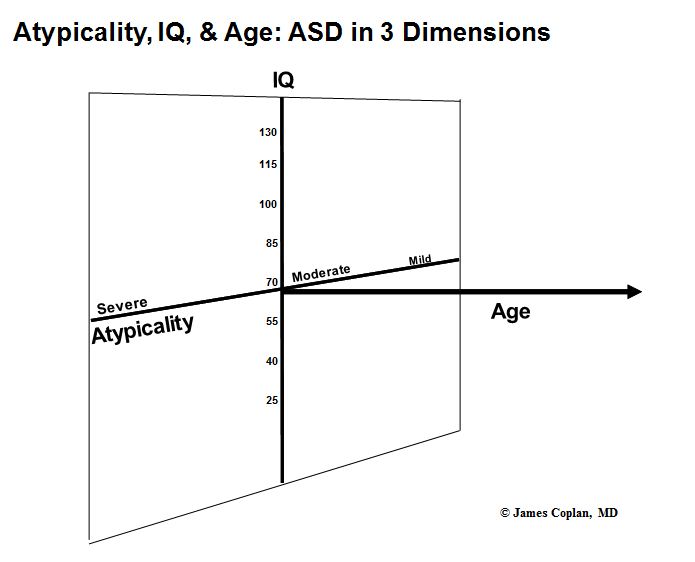Beyond the DSM: Seeing ASD in 3D, Part I
If a picture is worth ten thousand words, then here’s the picture:

This is a 3-dimensional graph, showing Degree of atypicality on the X axis, IQ on the Y axis, and Age on the Z axis. Over the next couple of posts, I will explain how I created this graph, and why it is important to you, whether you are the parent of a child with ASD, a therapist or educator working with children with ASD, a researcher interested in the epidemiology of ASD or the efficacy of various interventions for ASD, or if you are an individual with ASD yourself.
And if you are uncomfortable with graphs, don’t worry! I have a way to explain what we’re getting into, that won’t require you to use graphs.
Everything starts with this paper, written by Leo Kanner (a child psychiatrist) in 1943:

If you haven’t read this paper, you owe it to yourself to do so. Click here for a PDF of the paper. (Be patient: It’s a big file, and can take a minute to load, if you have a slow connection.) In this paper, Kanner describes 11 children (8 boys, 3 girls, ranging from 2 to 8 years of age), all of whom had what we would consider today to be classical autism: he described these children as “aloof, withdrawn,” with echolalia, repetitive behaviors, and sensory aversions and attractions –the very same features we use today, to diagnose ASD. In addition to being the first modern description of autism (there had been earlier reports in the 19th century), Kanner’s paper was also a five year longitudinal study of outcome. And what he described was a steady improvement, in the absence of treatment (in 1938 there was no such thing as ABA, VB, Special Instruction, Early Intervention, or any of the other therapies or services we take for granted today.) Here is what he wrote:
“Between the ages of 5 and 6 years, they gradually abandon echolalia and learn spontaneously to use personal pronouns… Language becomes more communicative, at first in the sense of a question-and-answer exercise, and then in the sense of greater spontaneity of sentence formation…. Food is accepted without difficulty. Noises and motions are tolerated more than previously. The panic tantrums subside. The repetitiousness assumes the form of obsessive preoccupations… Reading skill is acquired quickly, but the children read monotonously, and a story or a moving picture is experienced in unrelated portions rather than in its coherent totality. [We now refer to this as “central coherence”] … Between the ages of 6 and 8, the children begin to play in a group, still never with the other members of the group, but at least on the periphery alongside the group… People are included in the child’s world to the extent to which they satisfy his needs… All of this makes the family feel that, in spite of recognized ‘difference’ from other children, there is progress and improvement.”
So, from the very beginning, we have known that children with ASD change over time. Here is a table that summarizes different levels of impairment in persons with ASD. We can consider this table as a snapshot of different persons with ASD at the same moment in time, or we can regard it as a map that lays out the predictable changes that occur over time. Not every child starts at the far left, and not every child makes it all the way to the far right. There are even a lucky few who go all the way off the right-hand edge of the table, and “lose the diagnosis” (although this does not mean that they are “cured,” or that they are “all better now.” (This table is based on Table 1.2 in my book, Making Sense of Autistic Spectrum Disorders.)

Summarizing all of the items in the table above gives us a horizontal line, with Severe Atypicality on the left, and Mild Atypicality on the right, like this (redrawn from Figure 5.1 of Making Sense of Autistic Spectrum Disorders):

James Coplan, MD is an Internationally recognized clinician, author, and public speaker in the fields of early child development, early language development and autistic spectrum disorders. Stay connected, join Dr. Coplan on Facebook and Twitter.














Leave a Reply